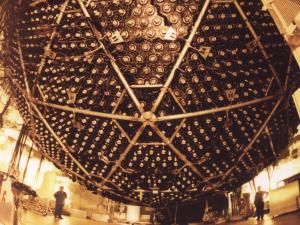Blog
Neutrino Rain
6 October 2014
 Sudbury Neutrino Observatory
Sudbury Neutrino ObservatoryYesterday I talked about the weirdness of neutrinos, specifically that there three types of neutrinos (known as flavors), and they can oscillate between different flavors due to the quantum fuzziness of their masses. If you go back and read that post, you’ll find its a pretty bizarre model that seems to assume a great deal just to solve what is known as the solar neutrino problem. So how could we possibly know that such a model is correct?
The short answer is that our neutrino detectors got better, but the more detailed answer is a nice demonstration of how evidence builds to support even strange models such as neutrino oscillation.
The earliest direct detection of neutrinos in the 1950s used a nuclear reactor to produce neutrinos from radioactive decay. The detector consisted of tanks of water, so that high energy neutrinos would strike protons in the water creating a positron and neutron. The positron then collided with other material to create two gamma rays, which could be detected. This experiment demonstrated that neutrinos were real, but wasn’t sensitive enough to gather detailed information about them.
The first observation of solar neutrinos was done by the Homestake experiment in the late 1960s. This was performed in a gold mine in South Dakota, and involved a large tank of perchloroethylene (commonly used in dry cleaning). Since it was buried deep underground, it was shielded from things such as cosmic rays. When neutrinos from the Sun struck chlorine in the perchloroethylene, it caused it to decay into a radioactive isotope of argon. By analyzing the amount of argon produced, the level of solar neutrinos could be determined. It was this experiment that first found that the level of solar neutrinos was a third the expected result.
The Homestake experiment (and similar experiments done later) could only detect electron neutrinos, but by the 1990s the Sudbury Neutrino Obervatory (SNO) was created to detect all flavors of neutrinos. The SNO detector was also buried in a mine, this time in Sudbury, Canada. This experiment used a large tank of heavy water, which is water made with deuterium instead of hydrogen. Deuterium is an isotope of hydrogen that contains a proton and neutron, rather than just a proton. When a neutrino of any flavor strikes the deuterium, one of two things can happen. Electron neutrinos can cause the neutron to become a proton and electron. Neutrinos of any flavor can cause the proton and neutron in the deuterium to split, created hydrogen and a free neutron. So the SNO can detect both the total number of neutrinos and the number of electron neutrinos. It was this experiment that confirmed that the Sun did, in fact, produce the expected number of neutrinos.
So this told us that our predicted level of neutrinos was correct, and that only a third of the neutrinos reaching Earth were electron neutrinos. But how do we know that neutrinos actually change flavor? If the Sun produced neutrinos in equal amounts, that would match the data as well.
The answer was found by another observatory, the Super-Kamiokande detector in Japan. This experiment is also buried in a mine to shield from cosmic rays, and involves a large tank of pure water surrounded by photomultiplier tubes. The detection method is similar to the Homestake experiment, but with vastly greater sensitivity. Super-K is so sensitive that it can distinguish between electron and muon neutrinos. It can also determine the direction of origin of these neutrinos. Because of this, Super-K could perform an ingenious experiment.
In addition to being produced by the Sun, neutrinos are also produced by cosmic rays striking the Earth’s atmosphere. When cosmic rays strike the atmosphere, they produce a cascade of energetic particles, including electrons, muons, and their corresponding neutrinos. According to the standard model, the number of muon neutrinos produced should be double that of electron neutrinos. What Super-K found was that the number of muon neutrinos was on average only about 28% greater than the number of electron neutrinos. But because Super-K can identify the direction of the neutrinos, it can distinguish between ones produced by cosmic rays directly over the mine, and ones produced on the opposite side of the Earth. When they looked at the highest energy neutrinos on both sides of the Earth, the Super-K team found that when they came from directly overhead, muon neutrinos were double the electron neutrinos. When they came from the opposite side of the Earth, they were an even mix of electron and muon neutrinos.
This is exactly the result predicted by neutrino oscillation. Neutrinos originating from overhead only travel through a few thousand meters of Earth before reaching the detector, and therefore have little time to oscillate into other neutrinos. The ones originating on the far side of the Earth travel through more than 12,000 kilometers of rock to reach the detector, and by then have smeared out into equal amounts of neutrino flavors due to neutrino oscillation.
So as strange as the neutrino model is, it really works. We can prove it. There are still things we don’t know about neutrinos. For example, we know there are three types of neutrino mass, but we don’t know what their values are. We have an idea of their upper limit, but we lack the precision to pin them down. And we’d really like to know, because the results will have cosmological implications.
But we’ve come a long way in neutrino physics in the last 60 years, from their first detection to the confirmation of their complex behavior. And that’s quite amazing when you think about it.